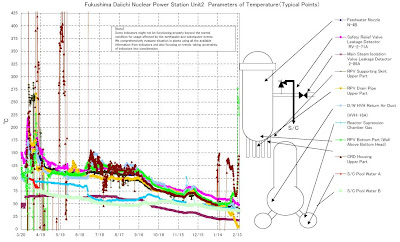It doesn't look like the behavior of a thermocouple that has been broken, but what would I know?
From TEPCO's plant parameter, Reactor 2 RPV temperatures, hourly (latest: 2/15/2012 10AM):
In the meantime, the temperature at the CRD (control rod) Housing has been rising again. Again, instrument failure. (Brown line in the graph. 69H1 is light green.)
From TEPCO's plant parameters, Reactor 2 RPV temperature (2/15/2012):
戦争の経済学
-
ArmstrongEconomics.com, 2/9/2014より:
戦争の経済学
マーティン・アームストロング
多くの人々が同じ質問を発している- なぜ今、戦争の話がでるのか?
答えはまったく簡単だ。何千年もの昔までさかのぼる包括的なデータベースを構築する利点の一つは、それを基にいくつもの調査研究を行...
11 years ago





 Tokyo Time
Tokyo Time
![[Most Recent Quotes from www.kitco.com]](http://www.kitconet.com/charts/metals/gold/t24_au_en_usoz_2.gif)


5 comments:
Thank you, Ex-Skf.
And what about Xenon detected in reactor 2 containment vessel?
http://www.tepco.co.jp/en/nu/fukushima-np/images/handouts_120214_07-e.pdf
Tepco said: no Xenon, no ongoing nuclear fission...
OH..Tepco just raised the "detection" limit so they could say "no-detectable" Xenon. What sneaks they are.
Watch what Tepco does and ignore what they say (lie). They're still pumping 18 tons of water into reactor unit 2 every hour. Looks like the boric acid is ongoing as well. Certainly there is nitrogen being pumped into the containment. Hydrogen requires a lot of energy to produce, powerful chain reactions.
In a fast reactor the production of Xenon-135 will throttle the chain reactions as it is produced. The chain reactions will slow because Xenon-135 is a strong neutron poison. As the Xenon is saturated the chain reactions start up again, producing more Xenon and the cycle is repeated. Temperatures have risen in this reactor before and are likely to do so again.
Tepco is also probably detecting Iodine isotopes and Chlorine, too but not reporting them. There is also a flux of fast neutrons but these cannot be detected without special detectors which Tepco should install within the reactor.
@anon at 12:53AM, yes, xenon has been detected, for a while (since last November). As long as it is below the level they set (Xe-135 at 1 Bq/cm3 I think) they are not worried.
Post a Comment